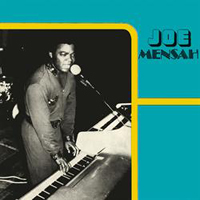
JOE MENSAH
CRY LAUGHTER (Soundway)
Soundway, very considerately, reissued this rare album for record store day May 2016 on heavyweight vinyl. It is now out of print, but you can still get MP3 files of it to enjoy the crystal clear sounds of a classic Nigerian highlife album, originally put out by the Decca label in Lagos around 1975. There's little info about Joe on the net, other than he was a renowned highlife musician in the 50s and 60s and was first president of the Ghana Musicians Union. He performed with the Super Sweet Talks as well as Stargazers, Uhuru and Broadway Dance Bands. Also he studied at Juilliard in New York and broadcast a radio show from Columbia University. "Cry laughter" is clearly a case of close your eyes and imagine Miles in Africa, especially once the title track gets into its groove. Joe is on keyboard but his arrangements give a lot of room for the afrogroove to spread on guitar and percussion (I believe the backing band here is indeed the Super Sweet Talks which at that time would have included Solo Mensah on guitar, J. Y. Thorty on drums, Lord Sekyi on percussion, Ekow Tuyee on percussion, Prince Kelly on trumpet and Tex Kortley on saxes). Like many highlife albums of that era there's a long superb jam on the A-side, spanning 18 minutes, then two lesser tracks that are 8 or 9 minutes each on the B-side.
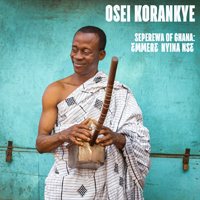
OSEI KORANKYE
SEPEREWA OF GHANA (Akwaaba Music)
Akwaaba is a label dedicated to bringing new African music, particularly Ghanaian music, to the rest of the world, and does it digitally (to keep overhead down). Label founder Benjamin LeBrave finds that there is even a market in Africa for other African music and is trying to network from his base in Ghana, where he works as a DJ as well as producer. His latest release is a traditional one, and really strikes a chord, literally and figuratively. The seperewa is a harp played by the Ashanti and Akan people, a traditional Ghanaian instrument that looks and sounds, to some extent, like a stripped-down kora. Though it is centuries old it almost vanished when the guitar came along and spread inland from the coast in the early 20th century. But the seperewa repertoire was transferred to the guitar so didn't die out. The number of strings is variable; Osei, who learned from his grandfather, went up to eight and then ten strings in his own instrument which further distinguishes it from the sound of a guitar. The songs were indigenous to Ghana throughout the nineteenth century and are quite different from Malian kora tunes. You can sample it on the Akwaaba website, and that will make you want to own this wonderful collection.
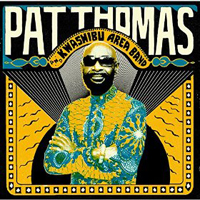
PAT THOMAS & KWASHIBU AREA BAND
S/T (Strut Records)
One problem I have with modern Afrobeat bands is the simulacrum of the music they represent. You can listen to a Fela album and imitate the choppy guitar, any sax player can produce a credible Fela-sounding solo, and a talented drummer can anatomize the structure, but it is only a superficial resemblance and unlikely to go anywhere unexpected. It is not a living part of your experience, only a recreation of someone else's reality. But Fela and a lot of the other pioneers of Afrobeat and Highlife are dead. Not so singer and bandleader Pat Thomas. He moved to Germany in the 80s and with George Darko created a new type of music known as Burger Highlife, which had elements of disco (& is as dated as it sounds). Now, after 50 years in the business, Pat Thomas has returned to Ghana to wax some tracks: old favorites with old pals. He started out in the Broadway Dance Band and the Stargazers in the 1960s (singing often in English), alongside Ebo Taylor, who has also emerged from retirement to critical acclaim from a younger generation. Thomas was prolific in the 80s, touring Europe and the USA. The drummer from Fela's band, Tony Allen, also pops up on a couple of tracks to add his unmistakable driving touch, but in general Highlife is lighter and more melodic than Afrobeat and that bright sound is paramount here. Among the guests, Osei Tutu, trumpeter from Hedzolleh Sounds who was with Taylor and Thomas in Marijata band, appears. The rest of the band are younger members of the regenerated highlife scene and they run through some oldies from Thomas' catalogue, including "Gyae Su," "Odoo Adada" and "Mewa Akoma," which kicks things off in high style. They left the drum machine and synths in the closet so it's a fresh-sounding set of classic Highlife, the kind that cannot be replicated by wanna Afrobeaters. There are also a couple of new compositions, carried out in the traditional 70s mode.
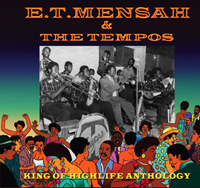
E. T. MENSAH & THE TEMPOS
KING OF HIGHLIFE ANTHOLOGY (RetroAfric24CD)
I thought the RetroAfric label was moribund: it's been 8 years since their RyCo Jazz compilation, and a decade since they updated their website. When I saw this new compilation announced I thought they were just repackaging their first two CDs which were devoted to E.T. Mensah: All for You (Retro 1CD 1986) and Day By Day (Retro 3CD 1991). While the music was good on those issues, the monochrome covers were uninspired. The last twenty-five years have seen major changes in the way music is delivered but the sound quality has not necessarily improved and one thing that now makes some labels stand out is their packaging and attention to detail (Analog Africa and Planet Ilunga come to mind). So I was pleasantly surprised to find this new package is a legible 64-page book with an nifty accordion insert at the back to hold 4 CDs. Mensah's career began in the 78 era (which had a long run in Africa), and extended into the EP and LP age. John Collins, the pre-eminent authority on Highlife music, wrote the booklet: it is the result of many days of interviews with Mensah and other musicans, conducted in 1974, and makes this the definitive work on Mensah as well as the cornerstone of any Highlife collection. But in addition to dance-band Highlife, Mensah recorded many calypsos in the 50s and 60s, as well as occasional forays into rhumba or samba. 'The Tree and the Monkey" shows the versatility of the band as well as the reach of styles here: it's a calypso sung by Juliana Okine, one of the first female vocalists on the Gold Coast; there is bongo and clave percussion and the accompaniment features muted trumpet (Mensah himself) and sprightly clarinet with a strong baritone sax solo. The "Tea Samba," another calypso, also in English, appeals strongly to me: it almost sounds like it was written as a commercial for the tea board. The guitar is in 50s jazz mode, with single string plucking. The singing is also uncomplicated: "It's refreshing as can be, you can make it easily. Hey mama, pour me out another cup of tea!" I like the English songs because they are most memorable to me. "School girl," "Because of money," "Don't mind your wife," and many others pop out insistently. But the instrumentals are equally compelling and show affinities to American jazz in the way the horns get a crack at a solo then join in unison for the chorus in the mostly under-3-minute tunes. "Mucho mambo" is one wonderful example. Their earliest recordings from 1952 are included and you will note how they leaned on imported music from other cultures, so we hear "Sly Mongoose" (first performed by Lionel Belasco of Trindad in the early 1900s) refigured as "All for You," and you will not be able to resist singing the Beach Boys' lyrics to "Sloop John B." Of course the opposite happened when Louis Armstrong came to town in 1956. Armstrong thought "All for You" was an old creole melody from Lousiana, whereas the locals argued it was an older Gold Coast melody that had gone to the new world with the slaves. The fascinating book tells the tale of break-ups, which seemed to happen with frightening regularity but somehow Mensah always managed to pull it together with new recruits. The untold story is that he was probably a tyrant or kept more than his share of the proceeds or else his band would have been happy to have the regular gig and acclaim. However this proving ground led to many other early pioneers of highlife setting up their own bands: King Bruce, Guy Warren and Saka Acquaye among the first. Subsequent bands left to form the Rhythm Aces and the Stargazers. Whenever he was on tour, it seems, sneaky club owners stole his musicians and tried to recreate his sound without him. However he toured to Nigeria regularly because it was lucrative and his music was greatly appreciated, to the extent that Nigerians soon began to develop their own form of Highlife. Rex Lawson and Victor Olaiyo both adapted Mensah's music to their own ends, with great results. Independence from Britain in 1957 should have been a great beginning, but had unfortunate consequences for Mensah. Inflation caused his club to falter, as beer prices rose 50%. He wrote a song celebrating the new era, "Ghana Freedom," and was Ssummoned to the government offices. He thought he was going to hear praise for his contribution, instead Nkrumah was pissed off that other politicians were name-checked along with him. Decca had already pressed 10,000 copies of the disc. Mensah sent them a lengthy telegram explaining the situation and the engineers managed to remaster the disc with "politically approved" lyrics that only mention Nkrumah! This song is the germ of many highlife tunes that followed, both in structure and instrumentation. There is some appalling Spanish in "Señorita," however this is one of my favorite tracks. Described as a "congo," it packs a lot into three minutes. While it's nothing a Cuban would recognize, it has great feeling and segues into "Daavi Loloto, a "cara cara" sung in Ewe that picks up the tempo but is similarly propelled by a great bass riff. This time the trombone gets to trip out. Superb musicianship packs this set from front to back. You will hear why Mensah is truly the "King" of highlife.
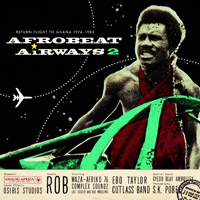
AFROBEAT AIRWAYS 2
RETURN FLIGHT TO GHANA 1974-83 (Analog Africa AACD074)
There's nothing like a comparison to give you some perspective. I played this and then put it aside. I am not the huge fan of Afrobeat that everyone else on the planet seems to be. Fela was fine in moderation but there is so much more to West African music than cover bands trying to be the Famous Flames. However, then I got the latest RED HOT + FELA comp which provided a stark contrast. This is not RED HOT + RIOT (a fine album) which came out in 2002, but a new foray into covers of Fela tunes. Man did it stink! I listened to the whole thing, wondering what the hell they were thinking, though it's easy to imagine music executives making such bad choices when they try to shoehorn flash-in-the-pan acts into an older artist's repertoire for "relevance," "market appeal" or whatever. So then I put the Afrobeat Airways 2 on again and it sounded fresh and exciting! Yes, it's the familiar hit-it-dont-quit-it groove that you, apparently, know and love. There are strong currents of highlife though, as well as soul and rock, so the funk doesn't submerge it. It's also sequenced properly so you get established acts like Ebo Taylor followed by someone you've never heard of -- De Frank -- doing their funky thing. De Frank is an odd band, their second song included here "Waiting for my Baby," is an afro-take on "Louie Louie," which is truly odd. I imagine a whole album by them would be insufferable, but Samy Ben Redjeb, the producer of this series, has picked the plums for inclusion here. Rob -- you remember him as a most credible Fela imitator -- returns with "Loose up yourself" which he calls a "sexy" song, a sustained groove with grunts and an opportunity to express yourself in dance, and impress the opposite sex. There's a great instrumental called "I Beg" by Tony Sarfo & the Funky Afrosibi, but Samy saves the best for last. The outstanding track, to my mind, is "Say Min Sy Soh," by Pierre Antoine. It doesn't sound like anything else on here, but much more like the Voodoo funk Samy has been documenting on his Beninois compilations (also from Analog Africa). Antoine came from Abidjan and sang in Agni (a language from southern Ivory Coast), and this was his first hit after he moved to Ghana in 1977. The last cut, Complex Soundz' "God is Love," returns to the familiar Afro-American funk, but we realize we have been on a trip, not on an airplane so much as a mental one. Complex Soundz' conga player was called Samy Go-Slow: they started out as a copyright (i.e. cover) band until Gyedu-Blay Ambolley (who was in Uhuru Dance Band with Ebo Taylor) joined them for the album sampled here. In Ghana, Highlife was still the dominant musical mode in the 70s so funk tracks were relegated to the B-sides of records and only now these tracks are reemerging from the shadows. If you have Ghana Funk (on the Dutch hipporecords label), which includes C.K. Mann, Rob, Ebo Taylor, Gyedu-Blay Ambolley and Cutlass Dance Band, you probably will want to add this to your collection too. In addition there is a lavish 44-page booklet crammed with info and rare photos.
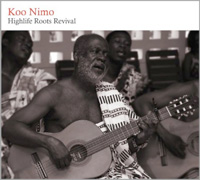
KOO NIMO
HIGHLIFE ROOTS REVIVAL (Riverboat TUGCD1064)
A veteran of the palm-wine scene in Ghana, Koo Nimo has spent his years under a tree in his backyard, spinning yarns to the gentle accompaniment of guitars and percussion. (You can even hear a cock crow.) It's all very relaxed and fits well with other world traditions of simple sung stories like calypso (which was also big in West Africa) or mento. The songs benefit from an English translation, so download-only purchasers will be left in the dark. Though he normally sings and plays solo, here Nimo is backed by a large array of friends, a vocal chorus, a lot of percussion (people clashing metal things together), a seprewa, traditional drums and so forth. The 77-year-old Ghanaian is a fan of Thelonious Monk, though you can't tell that from his playing. The lead cut, about a blood-sucking tsetse fly, is an allegory about landlords. "Old man plants a coconut tree" simply says that even though he wont live to see it bear fruit, an old man plants trees for the future. "Integrity" is about a cat and a dog. One is caught stealing because he left footprints in the sand. The moral is, if you do a job, do it well. "Nation building" recalls the parable of the ants who store food for a rainy day. Anansi, the spider, on the other hand, is a trickster who always ends up broke. The album has an enduring appeal, the singing is wonderful as is the percussion, and the variety of other instruments, including two different seprewa players, keeps it moving forward.
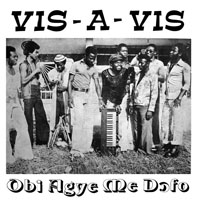
VIS-A-VIS
OBI AGYE ME DOFO (Secret Stash)
Secret Stash are building an impress catalog of classic West African reissues. Not funk this time (beyond the title track), but old school Ghanaian highlife music from 1977. It's really well done, but there is an irritating wanky synthesizer on here, on the first track, which kind of spoils it when he solos, otherwise great singing, fine guitar, sax and percussion. Mercifully after the first track the keyboardist mainly plays organ. The B-side, tracks 3, 4, & 5, are one long hypnotic groove. This was K. Frimpong's band and were originally known as the Cubano Fiestas when they backed him, featuring in their ranks Isaac Yeboah on vocals, Sammy Cropper on guitar, Slim Manu on bass and Gybson Papra (a.k.a. "Kung-fu Kwaku") on drums. Hornsmen were Arthur Kennedy or George Amissah who guested on dates. Their sound will be familiar even if you have never heard of them because they were the backing band on so many studio dates for Ofo Brothers Records. They released over a dozen albums in the 70s, some even on the Brooklyn-based Makossa label. Secret Stash are offering a bonus reggae 45 rpm by the band to the first so many orderers and also a free download from the album for a limited time, through their website. In addition to all that there is a 200 copy vinyl release. The sound has been "stabilized" & lovingly remastered.
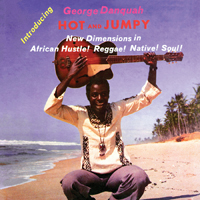
GEORGE DANKAH
HOT & JUMPY (Secret Stash)
Funky Kingston, Funky Oakland and of course Funky Accra. Yes, Ghana was not lagging behind in the funk stakes in the 1970s. Uhuru Dance Band, African Brothers and Gyedu Blay Ambolley have all been collected on the various African funk anthologies. I thought I had heard of George Dankah but looking around my archives I don't find any mention of him. This is his sole album; however he did perform as a sideman with CK Mann, Ebo Taylor and Pat Thomas, as well as the Uhuru Dance Band. It's highlife and breaks into funk strategically. There's a reggae sensibility underlying the rhythm guitar (who gets to work it on "African reggae," managing to sound like Ernie Ranglin) and a soul feel in the horns, not to mention jazz flute, so all bases are covered. This is very accomplished and entertaining. With the renewed popularity of LP records, Secret Stash is issuing 100 copies on pink vinyl. Side Two (if you are into vinyl) kicks off with "Why worry, baby -- let's do the highlife" just to reassure you that the band has not lost their feel for the sweet sound, and they continue with a vocal version of the opening cut "Mbesiafo" which is definitely in the tradition, 'til they get to the bridge. It's reassuring to have a set of traditional highlife as the B side, making it one of those albums you flip over at the end to start afresh.
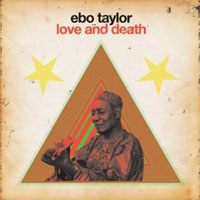
EBO TAYLOR
LOVE & DEATH (STRUT 073 CD)
Though he is considered one of the elder generation of Ghanaian artists, Ebo Taylor is alive and well and visiting Berlin from where he has recorded a fresh set of Afrobeat music. He doesn't break any fresh ground but instead treats us to an enjoyable set of new material with some exceptional sidemen, drawn from the Afrobeat Academy of Berlin. In addition to the new songs there are two classics from his repertoire, "Love and Death," and the instrumental "Victory," which appeared on an album in the 1960s called Conflict Nkru! From the outset the Berliners lay down a tasty and relaxed groove with echo on the horns and complex propulsion from the kpanlogo, gome, maracas, clave and bells. The arrangements are great, the unison and solo playing are fine. They could easily be Nigerians, because they don't sound like strangers to the groove. "Kwame," an instrumental dedicated to the great Dr Kwame Nkrumah stands out. The title track is also exceptionally good. Taylor sings and plays guitar: he seems to be getting on in years, but the youthful energy of the band supports him admirably. There are a couple of slower numbers which work well in the flow.
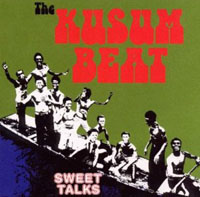
SWEET TALKS
KUSUM BEAT (Soundways)
Another disc from the great Ghanaian highlife band resurfaces. Six tracks from A.B. Crenstil, Yorthy, Kennedy and Flyne guaranteed to get you bopping about. This is the album that broke the Sweet Talks from Ghana to the rest of the world in 1974. One of the characteristics of the Sweet Talks' sound was their non-stop style of playing, as songs flowed into one another. Since the 1970s most Nigerian and Ghanaian bands have adopted this, so the unmistakable "groove" is something we expect from Sunny Ade, Chief Stephen & other performers. Here they went from slick dancefloor pleasers to a more Afro sound, incorporating traditional rhythms. The band comprised ten instrumentalists, all top flight. After three albums recorded in Ghana they toured the USA and recorded some more disco-oriented funk aimed squarely at the American market. In addition to the Soundways release of this album there is another version available from Tropic Vibe Productions that also includes the ADJOA album, which also dates from the 1970s. Those three tracks were also included on the Stern's compilation The Lord's Prayer, which was a compilation of tracks from the same era as Kusum Beat. If you have Adam & Eve and Hollywood Highlife Party you will want this. This is one band you will be sorry to complete your collection of, because you will assuredly want more.
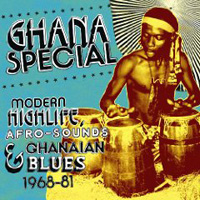
GHANA SPECIAL
MODERN HIGHLIFE, AFRO-SOUNDS & GHANAIAN BLUES 1968-81 (Soundways CD016P)
In my ongoing struggle with the intangibility of downloaded music, I am enjoying the latest foray into Ghana's past from Soundways. There is a rich, 48-page full-colour booklet to show you the artists, and explain the lyrics. It's real, and a treat. You get drawn in right away by the lilting rhythms, the seemingly dissonant harmonies, mellow relaxed guitar & complex percussion. "Aaya lolo" by the oddly named Barbecues (an offshoot of King Bruce's Black Beats) is wrapped around a Santana riff on the organ. Well, Santana got their start with Peter Green's Fleetwood Mac riffs, so all's fair. My taste for this music was instilled by the Ramblers, and " Nya Asem Hwe" by City Boys Band, sung in Twi by "the black Chinese" J.A. Odofo, reminds me of the Ramblers' sound. Dr K. Gyasi & His Noble Kings turn in a slow highlife called "Sei nazo" based on the "Peanut vendor" changes which always warms my cockles. He started out in the 1950s and was still scoring hits in the 70s, alongside C.K. Mann, who was on the same label. Inevitably we get to the James Brown impersonation: this time out it's The Big Beats with "Mi nsumõõ bo dõnn." (Yes, those are tildes on the "o"s.) And then there's a track that is so irritating I had to delete it: "Obi agye me dofo" by Vis-a-Vis. They featured sensational guitarist Sammy Cropper and Kung-fu Kwaku on drums, who backed Frimpong on many of his hits. This cut however has the world's worst synthesizer solo and is a pain to hear. But there's plenty good stuff: Like "Odo Mmera" a lovely track from the African Brothers in 1968 before they hit it big. Nana Ampadu is unmistakable in his singing and control of the groove. The guitar is classic African Brothers. They come back as the African Brothers International to launch disc two. As Miles Cleret explains: "Wompe Masem" is is taken from the 1976 LP Emaa Bekum Mmarima, which was recorded just after the band had returned from their first tour of the USA. By this time they were sitting undisputedly at the top of the pile of approximately 150 electric guitar bands operating in Ghana. With more than 200 45s and roughly fifty LPs under their belt by 1976, no one could accuse them of idleness. The band operated a twelve-piece system at this point with four guitars, a four-piece rhythm section and ancient Amuah on organ..." Musically this is even more wide-ranging than Giants of Danceband Highlife or Telephone Lobi that came out on Original Music in the mid-90s. Another great chunk of timeless music.
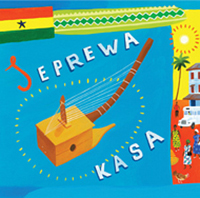
SEPREWA KASA (TUGCD1051)
This is really cool: Unplugged highlife music. I know people like the rocky rolly stuff, the Afro beats James Brown upside the head remixes, but give this a chance. The seprewa is like a stripped-down kora, it's a Ghanaian instrument but no longer played very much. Even Kari Banaman, guitarist from the 70s African band Osibisa, had heard about it but not actually heard it, until he encountered a seprewa player at a music festival in Switzerland. After jamming backstage the two met back in Ghana and recorded this sweet tribute to the roots of highlife. Osei Karankye, the seprewa virtuoso, was taught by his grandfather and now teaches at the University of Ghana in Legon. Another teacher, Baffour Kyerematen, one of the dance faculty, is also a seprewa player so the three men jammed under the palms. It is a relaxed and melodious set. The ten-stringed chordophone of course predates the guitar and was popular among the Akan people of the Ashanti from the seventeenth century onward. As the two seprewa players on the album had firmly held and divergent ideas about tuning they could not play together, so alternately played calabash, metal claves, bass drum, or other percussion while the seprewa duets with the guitar. In a song like "Towoboase" you can hear the connection to Rex Lawson, echoed not a little in the guitar. On "Agyese Wobre" you detect, perhaps, the origins of banjo music. Fascinating, and music-making of the highest calibre.
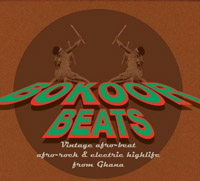
BOKOOR BEATS:
VINTAGE AFRO-BEAT, AFRO ROCK & ELECTRIC HIGHLIFE FROM GHANA (OTRABANDA OTB08)
Bokoor Studio is now well-known as the home of Ghanaian highlife music during an important formative stage when military curfews closed the clubs and bands would hang out in Bokoor and jam all night. There were no clocks on the wall, and the engineer, John Collins, was also a musician himself. For this latest collection -- a sequel to The Guitar & the Gun (Earthworks), Electric Highlife (Naxos World), and other compilations of note -- Collins puts his own bands to the fore and gives us a really engaging picture of some lesser well-known Ghanaian sounds (from among the 200 artists he recorded). There's Fela's Afrobeat up front, but then we get into some more tribal rhythms that are, to me, equally engaging. As I have already reviewed this album in SONGLINES I thought a different approach might be welcome here, so wrote to Collins and asked him a few questions. Here's the exchange:
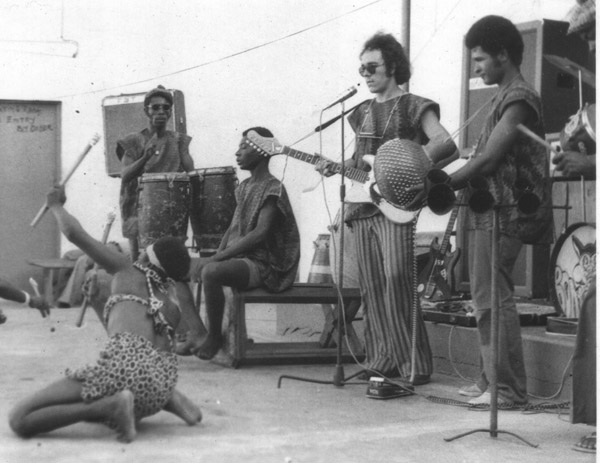
Bokoor Beats in Action
AJ: Your father was teaching philosophy at the University of Ghana when you were small. Did you grow up there, or in England?
John Collins: I SPENT A YEAR IN GHANA AS A CHILD IN THE 50'S THEN CAME BACK IN 1969.
AJ: Did you think Afrobeat would have such legs?
John Collins: YES I WAS LUCKY ENOUGH TO HAVE SEEN FELA PLAY IN THE 70'S AND I HAVE NEVER SINCE HEARD SUCH GREAT MUSIC.
AJ: There are many other styles of music on the new Bokoor Beats CD. Are these traditional styles dying out?
John Collins: YES, AS DURING THE LATE 70'S AND 80'S VARIOUS MILITARY GOVERNMENTS COUPS, CURFEWS KILLED OFF MOST OF THE LIVE POPULAR MUSIC.
AJ: Were you into the UK blues scene as a kid? I hear echoes of John Mayall in your harmonica playing on "Yeah yeah ku yeah," and even Paul Jones of Manfred Mann on "Been to" ...
John Collins: YES, I PLAYED IN A BLUES BAND, JAZZ BAND (GUITAR) AND ROCK BAND IN BRISTOL.
AJ: Anyway, they seemed quite "English" to me. How would you assess your personal impact on the sound of Ghanaian music, beyond selecting which bands to record at Bokoor?
John Collins: BEST ASK SOME GHANAIANS OR NIGERIANS THAT QUESTION.
AJ: I love the story you tell of the snake-dancer throwing her pythons out to disperse the mob when you had an equipment malfunction and seemed in peril of being beaten-up by the fans. I guess Ghanaians take their partying pretty seriously!
John Collins: IF YOU DONT SATISFY A PAYING GHANAIAN PUBLIC THEY RIOT.
AJ: Who are your favourite Ghanaian artists and which are your favourite recordings?
John Collins: I ENJOY OLD STYLE GUITAR BAND HIGHLIFE LIKE THAT OF THE AFRICAN BROTHERS, ALHAJI FREMEMPONG AND THE CITY BOYS.
AJ: What else do you listen to?
John Collins: I ALSO LOVE NAT KING COLE AND DEBUSSY.
AJ: Thanks!
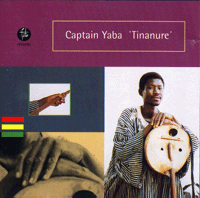
CAPTAIN YABA
TINANURE (FAB Records England FMFD002 1996)
Sooner or later someone was bound to take those funky riffs of James Brown & His Famous Flames that had such a colossal impact in West Africa in the 1960s and update them. The responsible party is Captain Yaba, who comes from Northern Ghana. Culturally he is part of the Fra Fra people, with more kinship to the sub-Saharan Guineans and Malians than the city dwellers in Accra. He plays the two-string molo, but it is no mean ax he wields. On this album he is joined by a heterogeneous group of talented musicians. No pedigrees or credentials are given. TINANURE means "let us unite," and the Captain has united strains of soul and jazz with impressive control on this shimmering album. One for the ages.
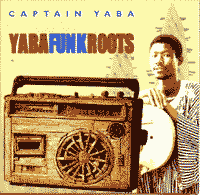
CAPTAIN YABA
YABA FUNK ROOTS (Retro 19CD)
There's a sad end to the story. This 2003 release is a reissue of TINANURE, for it represents the complete works of the great Yaba who died of TB in 2001, still only in his thirties. As you'll see from my other reviews in this section, I was wondering what had become of him after this stellar debut. RetroAfric remastered the CD and included the rough pre-mix tapes of the entire session, but left off one track. The reissue has liner notes by John Collins, the authority on Highlife music, and is a fitting testimonial to this great artist.
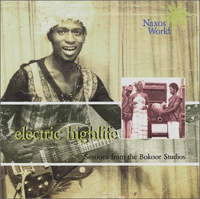
VARIOUS ARTISTS
ELECTRIC HIGHLIFE (Naxos)
ELECTRIC HIGHLIFE is a set of classic eighties Highlife from Ghana. The name "Highlife" covers a lot of sins, from palm wine music to brass bands to today's hip-hop influenced disco hits. In this case it's all good: guitar dance-band music. If you are a fan of classic highlife -- and who isn't? -- then check this one out. After the military coup of Jerry J. Rawlings there was a curfew so bands couldn't play at night. John Collins opened Bokoor ("Cool") Studios at his farm near Accra and many bands came to play and record, including the Black Beats who rose to fame under King Bruce. Francis Kenya (who was on the GUITAR AND GUN compilation) and the Guyoyo Guitar Band are strong entries here, with their minor key plaints over busy guitarwork. The Black Beats are represented with the lively "Tsutsu Tsosemo" that has an organ solo that sounds like an accordion. This is followed by trumpet and guitar solos and an instrumental bridge with great counterpoint on trombone. The music reveals the influences of colonial brass ensembles, sea shanties, finger-picked guitar, call-and-response vocals, choppy organs and sweet melodies.
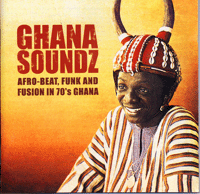
VARIOUS ARTISTS
GHANA SOUNDZ (Soundway CD distributed by Stern's)
Afrobeat is so prevalent these days it's almost mainstream. From new groups like Antibalas to reissues and remakes like the great RED, HOT + RIOT compilation, seems everyone is digging that "James-Brown-does-Africa" era of music. Now another great compilation has come out that has more than a few surprises, and a familiar "in search of the blue note" story: A young Brit gets so taken by the music he goes to Ghana to find rare vinyl in the markets. And of course there's the magic bit of serendipity: He asks someone where he can listen to records and is directed to the home of a young deejay. They start talking about the music. The record is by K. Frimpong and guess who walks in the door -- yes, the artist! Two years of intensive research and four trips to Ghana later we have this magnificent collection. Not just the names you know, like Alex Konadu, Sweet Talks, and African Brothers, but a whole crop of obscure ace tracks, B-sides and unreleased gems. This fan, Miles Cleret, did it right: he heard a great track on a scratched album and had to find the master tapes. He has crafted a superb compilation that has nary a slack second of sound on it. (Well, there is a horrid synth solo on the African Brothers' cut.) The booklet is a labour of love, informative and packed with photos, album art, & old posters that document this vital period of Ghanaian music, the seventies.
Lyrics in English make it easy to get into the groove, like when Gyedu-Bley Ambolley shows you how to dance the "Simigwado," a move doubtless akin to "walking the dog." This track, which really gets you moving, is taken from a 45 that was a huge hit, despite being banned from radio. The English lyrics and catch-phrases also lend a familiarity to the tracks, even though I'm sure I'd never heard any of them before. "Psychedelic Woman" by Honny and the Bees conjurs up lightshows and gogo dancers in a Peter Seller's "Party" kind of way, but it segues nicely into a smooth groove by Frimpong that no sooner starts than you are deep into a soulful sax solo, suggesting a top flight working band that could show Fela a thing or two in their day. After three minutes of solos, the vocals begin and the song coasts on for 8 minutes.
The sleeper on the album is a track by the artist known as Rob, called "Make it fast, make it slow." Inexplicably funky. It just gets under your skin with its calculated insistence.
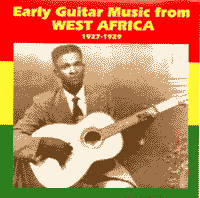
VARIOUS ARTISTS
EARLY GUITAR MUSIC FROM WEST AFRICA (Heritage HTCD33)
In January 1928 the Zonophone company began issuing 78s of popular music from the Gold Coast of West Africa that spanned Ivory Coast, Ghana and Benin. These were not field recordings of traditional music aimed at the anthropologist, but rather urban-syncretic tunes for the local market and expatriate Africans living in England. Some of the artists were in fact students living in England and therefore benefitted from the recording facilities available in London. This is the first commercially recorded West African music of any importance. It is truly amazing: slack key, Caribbean folk, Mississippi blues, are all prefigured here. Of course, we knew all along it would be there somewhere. The bright vocal and guitar of George Williams Aingo dominates the sound, as he appears solo and in duets and trios. Nicholas De Heer is another guitarist with remarkable skill. Kazoo and concertina are also featured, along with percussion on drums and castanets. There's even clarinet and piano. Most of the songs are sung in Fanti, with four in Ga (the most common dialects in Accra). Not for everyone, but fans of guitar, Highlife, or roots music in general will want it. It's not only important in that it's contemporary with Lonnie Johnson, Scrapper Blackwell and Louis Armstrong, it's also fun to listen to.
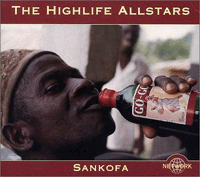
THE HIGHLIFE ALLSTARS
SANKOFA (Network)
SANKOFA is the title of a collection of classic Highlife from Ghana. This compilation also comes from Germany, courtesy of the Network label. The mellow lilting grooves of Ghanaian Highlife dominated the African airwaves in the 1970s until the dominance of Congolese music. Like Sunny Ade's better-known juju music, Ghanaian highlife also has roots in popular palm-wine music: simple acoustic guitar and percussion songs celebrating the joys of life when friends gathered for a few drinks and a few laughs. As the liner notes by Jon Lusk point out, the roots of Highlife are more complex, having elements of traditional music and hybrid forms of European military brass band and church music grafted on. From the local Fanti people came the Osibisaba rhythm; guitar styling came from nearby Sierra Leone. Gombe drumming, which originated in Jamaica in the late eighteenth century, was another key element. In the fifties the first big highlife star, E.T. Mensah, was influenced by calypso and American swing music from World War ii. At the end of the sixties the big guitar bands emerged: pre-eminent among them were Alex Konadu and Nana Ampadu & His African Brothers International. During a succession of dicey military regimes and general economic collapse throughout the 70s and 80s, a lot of musicians went into exile as groups disbanded. George Darko made a success in Germany with a techno style of music known as "burgher highlife," but the older style vanished. However it was not extinct as this album shows. Alex Konadu has absorbed outside influences including reggae but stays true to his roots. He returned to Kumasi and continues to write tunes in the old style. Kwadwo Tawiah retains an authentic palm-wine sound in his music. Prince Osei Kofi, who was a member of the African Brothers Band in the 70s and 80s, keeps that percolating sound alive with a big band. The album ends with a raucous rave-up by a stripped down brass band. "Sankofa" means "go back and retrieve" which is what these Ghanaian artists have done for a golden hour of classic highlife.
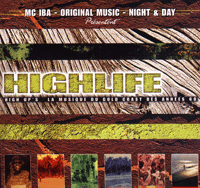
VARIOUS ARTISTS
HIGHLIFE: "High Ups: La Musique du Gold Coast des Annees 60," (Night & Day, France)
It's an odd phenomenon of CDs that you sometimes end up getting albums over again. Not that they are remastered or remixed, just resequenced or repackaged in a way that makes you hear them differently. On the downside are the screw-ups of the SONO 365 CD series: duplicated material, tracks at the wrong speed, albums split up and lumped with material from different periods. On the upside is something along the lines of the compilation HIGHLIFE "High Ups: La Musique du Gold Coast des Annees 60," a 2-CD set from the French Night & Day label that licensed tracks from John Storm Roberts' Original Music label. Roberts is a Brit living in the USA who discovered African music in his youth, working, I believe, for the BBC in East Africa. His modest label, based in upstate New York, put out 40 compilations of classic African music, largely from the '60s and '70s, taken from rare 78s. Original Music seems to have gone out of business about 5 years ago, and I hear Roberts is working with the Smithsonian Institution on their music projects. He has a knack for finding great obscure stuff. Sure we knew the Ramblers did a killer "Knock on Wood," but who could have imagined their version of the rocksteady gem "Ride your donkey"? Or what about Charlotte Dada's "Don't let me down," which takes a Beatles riff and transforms it into a compelling mating ritual with insistent metal percussion?! They were two of the highlights of "Money No Be Sand" which drew parallels between Highlife and rock, calypso, James Brown's influence, etc.
The French double-CD set is labeled "Highlife Ballades" and "Highlife Speed" which arbitrarily divides up the tracks, giving us 24 on each CD. Even if you have the Original Music albums you'll need this collection for the sequencing to play at your parties. For want of a better term, I have to say it's the Essential Guide to Highlife music. I wont bother listing the artists who range from the famous to the obscure, because all of the music is consistently great.
However, the liner notes are slapdash and badly edited, which is unfortunate given the effort expended on the package. (One parenthetical note left in the text says, in French, "quote to be verified.") There are no notes on the tracks unless you resort to the old Original Music liners, which were informative if poorly designed. The appeal of Night & Day's presentation however is that those Original Music CDs are no longer in print and despite the shortcomings of the package, the music should not be missed by anyone wanting an introduction to the Golden Era on the Gold Coast.
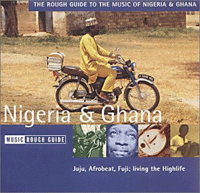
THE ROUGH GUIDE TO NIGERIA AND GHANA
(Rough Guide RGNET 1075CD)
Even without liner notes you'd recognize the music on THE ROUGH GUIDE TO NIGERIA AND GHANA -- I.K. Dairo, King Sunny Ade, C.K. Mann, Tony Allen, Captain Yaba, Adewale Ayuba, Sir Victor Uwaifo, E.T. Mensah, Eric Agyeman, Chief Stephen Osita Osadebe, and Sweet Talks comprise this album. From Highlife and Afrobeat to Juju and Fuji this CD covers all the bases in Anglophone West African pop. The only artist I didn't know was the last one, Amazeba Nat Brew who has five albums out in the speedy kpaalogo style which owes something to soukous and other international styles. This may be the future of the music but the more traditionally based artists like Chief Stephen still sound great (& appeal to me more). This album also reminded me we haven't heard from Captain Yaba since his killer debut funk album, TINANURE, six years ago. I'd have liked to see Celestine Ukwu in the line-up. But then there's also the African Brothers, the Oriental Brothers, Prince Nico Mbarga, the Ramblers and Rex Lawson -- enough artists in fact to make up a sequel, or call it a prequel and emphasize the roots. Then again Adewale Ayuba's "Fuji Shuffle" is as rootsy as it gets and will delight anyone just getting into Nigerian music backwards, that is through the recent popularity of Afrobeat. Unfortunately it's only a 6 minute piece, and Fuji kind of takes over so you need to play a whole hour's worth. But then the point of any successful sampler is to get you to buy the whole album sampled. This Rough Guide does a great job of covering all current styles while paying homage to the pioneers like Dairo and Mensah. This must have been an easy and fun compilation to put together and hopefully will expose more people to the deep riches in Nigerian and Ghanaian music.
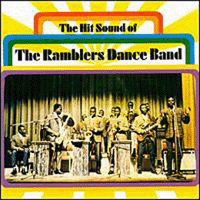
RAMBLERS DANCE BAND
THE HIT SOUND OF THE RAMBLERS DANCE BAND (Flametree UK 1995 FLTRCD 526)
From the mid-seventies comes this reissue of THE classic recording of Ghanaian highlife, the sweet percussive popular music that conjurs warm evenings in Africa where the dancers never stop except for a beer, and the stars seem palpably close. Saxophonist Jerry Hansen led this band, the first from Ghana to tour Europe. The two lead singers harmonize over snaking guitar lines and seething percussion. Tight horn arrangements allow space for flute, trumpet and sax solos. Alongside the indigenous West African rhythms such as the Akwete and the Kpanlogo, come some Latin and soul beats, peaking around a smoking cover version of "Knock on Wood." Big Steve claims to have started my passion for African music by loaning me this album in 1980. He may be right: it certainly got under my skin.
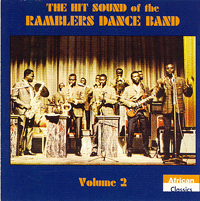
RAMBLERS DANCE BAND
THE HIT SOUND OF THE RAMBLERS DANCE BAND volume 2 (Flametree UK 1997 FLTRCD 533)
For those who can't get enough, there's an equally satisfying volume two of the Ramblers. The 15-piece band was formed during the Highlife boom of the 60s and survived for over two decades, with a regular gig at the top-flight Ambassador Hotel. Leader Jerry Hansen was elected first president of the Musicians Union of Ghana. From their many albums, Flametree has selected a dozen characteristic cuts and remastered them. Given how mellow and coherent this set is it is remarkable to note that not one of the band's top hits is included on this or the previous volume. So those of you with a taste for highlife will have to search for the vintage vinyl containing "Auntie Christie," "Scholarship," "Abonsam fireman," or "Eka wo ukoa."
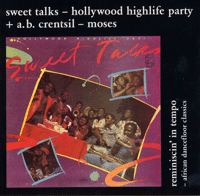
SWEET TALKS
HOLLYWOOD HIGHLIFE PARTY (Popular African Music pam adc 301)
Sweet Talks toured the USA in 1978. They backed the Crusaders, and took time to record their greatest album HOLLYWOOD HIGHLIFE PARTY, but then broke up over financial disputes. Various members, like A.B. Crentsil, Tony Mensah and lead guitarist Eric Agyeman went on to stardom as band leaders. Crentsil formed Super Sweet Talks and recorded the classic "Moses," another biblical rant which got him in trouble with the church at home and banned from the radio airwaves. The sixteen-minute "Moses" is included as a bonus on the "Hollywood Highlife Party" album, reissued by Popular African Music. Some of their most popular songs are here, including "Na wa' to be husband," and "Angelina." Bound to get your party hopping is the 16-minute "Ye wo adze a oye," which has long percussion breaks, and witty commentary about regional Ghanaian food and the peculiarities of the women who cook it.
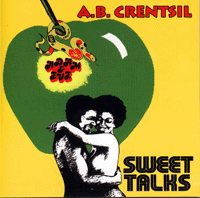
SWEET TALKS
ADAM & EVE (Ashanti Records ASHR2001)
African oldies are tops on my playlist. This reissue of A.B. Crentsil with Sweet Talks is outstanding. Crentsil was born in Ghana in 1950. As a teenager he started bands with more enthusiasm than chops (who didn't?) but soon had backing from a local factory and a regular gig. However inflation meant he never could make ends meet. In 1973 Sweet Talks evolved out of the earlier band with a new gig at the Talk of the Town bar in Tema and they recorded ADAM & EVE, now considered a classic Highlife album. Highlife itself was moribund at the time, languishing in the shade of American soul music which dominated West African taste. This album demonstrates the new laid-back style of longer tracks. Crentsil's irreverent lyrics add a new spin to the Old Testament while lead guitarist Smart Nkansah skitters about. Every now and then there's a sortie from trumpeter Arthur Kennedy or sax player Owusu. The mood simmers down to a mellow groove then starts to perc back up again. At 11 minutes, the title cut is a fine demonstrations of this style which was perfected by the time the band toured the USA in 1978.
The digitally remastered ADAM & EVE sounds great with the swampy guitar, churchical organ, trumpet interjections and rolling momentum.